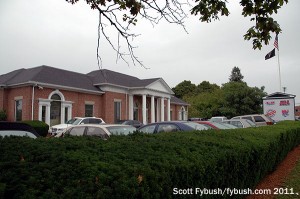NorthEast Radio Watch 11/18/2024: Sims Gets Yankees Callup
In this week’s issue… Yankees hire Dave Sims - Wallace, Maxwell move in NYC - Gray cuts news in Maine - Remembering CT's Pinto By SCOTT FYBUSH Jump to: ME - NH - VT - MA - RI - CT...
In this week’s issue… Entercom’s Boston spinoffs leave WBZ staff hanging – iHeart’s new Hub cluster raises questions – Magic trade for Beasley – Big DTV moves planned in repack – Smitty’s new gig
By SCOTT FYBUSH
*BANBURY, Oxfordshire, England – Cards on the table: this is not an easy issue of NERW for your editor to write. Boston’s WBZ was where I had a graduate-level education in newswriting and all-news radio, and while it’s been more than 20 years since I moved on to other things, it is and will always be a big part of my professional life. The people there – both those who still remain from my time there and the new friends I’ve made in the years since – are my friends. When they’re hurting, I’m hurting, and from across the pond, I’m sharing in the confusion this week as we try to figure out what this legendary radio station’s future looks like under the surprising new ownership that emerged on Wednesday as Entercom announced a complex shuffle of signals that will take the Boston market from four major commercial owners down to three.


When we tried to analyze all the potential players for the CBS/Entercom spinoffs a few weeks back, we didn’t spend much time on iHeart. Its shaky financial status didn’t seem to put it at the top of the list, and while the spins did include the two biggest markets where iHeart’s clusters were weak, it didn’t seem that the signals CBS and Entercom were spinning were especially good fits for iHeart’s programming strengths.
And then the news broke – iHeart getting those four Boston signals, plus an AM and two FMs in Seattle, in exchange for giving Entercom the iHeart clusters in Richmond and Chattanooga and a sum of cash that still hasn’t been disclosed. Was there any way that an iHeart-owned WBZ could make initial sense? There are, after all, some big AMs that have done decently under iHeart even in recent years: KFI in Los Angeles has stayed mostly local, shedding the corporately-mandated Premiere syndicated product to sister station KEIB. The same has mostly been true in Denver at KOA (and sister KHOW) and in Cincinnati at WLW (and sister WKRC).
When iHeart managers showed up at WBZ late last week to inspect their new trophy, they promised that Boston would go much the same way, with little or no change to the station that CEO Bob Pittman called “a national radio icon that adds to our portfolio of AM news and information icons like KFI in Los Angeles and WOR in New York City.” In a sufficiently optimistic frame of mind, one could even imagine a new iHeart AM strategy keeping WBZ’s all-local news and talk, pairing it with longtime rival WRKO’s local talk lineup, moving Premiere’s biggest talkers (especially Rush Limbaugh) to WRKO from their current third-tier home on little WKOX (1430 Everett, which iHeart will spin off as part of the deal), and maybe even putting another syndicated talk lineup as a flanker on WXKS (1200 Newton) once the Bloomberg Radio lease on that signal expires next year. That sort of lineup, if it were to happen, would make iHeart essentially the only player in commercial news and talk radio in the market – and would surely help Pittman’s stated quest to “increase our overall revenue from where we are today and build on our position as the leading media company in the U.S. by reach.”
And then reality began to set in. You’ll notice, perhaps, that while Pittman counted WOR as a “news and information icon” in his letter to iHeart staffers, we didn’t include it in our short list of iHeart AM success stories, and we probably don’t need to remind you why: when iHeart acquired it from Buckley a few years back, it was quick to undo a lot of what made the station unique. WOR’s own syndicated network went away, as did most of its local management and its distinctive personalities, replaced by Limbaugh, a morning show that’s struggled to find stability, and a bet on Mets play-by-play that hasn’t really paid off very well.


The reaction was fast and furious: no sooner did the letters leak to the Globe and other media outlets than the comments sections lit up with listeners worried that the WBZ they know and love will soon cease to exist. Within Soldiers Field Road, the uncertainty of the last few months turned rapidly to sadness and anger over the apparent disconnect between what iHeart senior management told staffers face-to-face Thursday and what they’re telling the union.
We’ll be watching closely, even from 4000 miles away, as the next steps play out: SAG-AFTRA leaders will meet with iHeart management at their local Medford studio this afternoon, and if they don’t get satisfaction there, they’re asking for a meeting at the WBZ studios on Tuesday so that union members can attend in person to, as union head Tom Higgins told them, “hear for themselves why iHeart thinks they can disregard our contracts and make staff apply to be ‘considered’ for their own job.”
Higgins told members he hopes to “get this transition on the right track (and) put this inauspicious beginning behind us.” And while iHeart’s history in these matters makes that seem less than likely, we’d remind the company that there’s a history of backlash to changes at WBZ that’s like few other stations in the country. (See “Brudnoy, David, and multiple attempts to go syndicated at night,” for just one example.)
We’ll keep you updated as this situation plays out – and we’ll have some more opinion to offer when we get back Stateside later this week, too.
(Multiple disclaimers apply here: in addition to having worked for WBZ, in a non-union capacity, your editor later worked for a subsidiary of iHeart’s predecessor Clear Channel Communications. All opinions expressed here are solely our own. But that doesn’t make us any less upset about the potential devastation of one of the finest radio newsrooms in the country.)
There’s much more, of course, to analyze about the Boston shuffle, and that continues over the fold for subscribers…
 The landmark 24th edition of the world-famous Tower Site Calendar is in production, and your support will determine whether it will be the final edition.
The landmark 24th edition of the world-famous Tower Site Calendar is in production, and your support will determine whether it will be the final edition.
It’s been a complicated few years here, and as we finish up production of the new edition (including a cover reveal, coming later this week!), we’re considering the future of this staple of radio walls everywhere as we evaluate our workload going forward.
The proceeds from the calendar help sustain the reporting that we do on the broadcast industry here at Fybush Media, so your purchases matter a lot to us here – and if that matters to you, now’s the time to show that support with an order of the new Tower Site Calendar. (And we have the new Broadcast Historian’s Calendar for 2025 ready to ship, too. Why not order both?)
Visit the Fybush Media Store and place your order now for the next calendar, get a great discount on previous calendars, and check out our selection of books and videos, too!
*While the biggest cloud of dust surrounds WBZ, there’s much more granular stuff in the air that still has yet to settle from last week’s developments. Remarkably, every major cluster in town ends up playing a role – it’s not just iHeart improving its own market position and Entercom moving some of its chess pieces around the board, but also a surprise swap with Beasley, which looked to be in a stable position with five successful full-signal FMs.


“This transaction will further diversify our Boston market content offerings with marquee sports programming and live game broadcasts of several of the most prominent and competitive professional sports teams in the country.” said CEO Caroline Beasley. That’s true – but it’s also a change from what we’ve come to expect from Beasley, which hasn’t been a big player in sports or talk programming in most of its bigger markets. In Detroit, it moved swiftly to ditch the FM sports talk format Greater Media had installed on WMGC (105.1), and in Philadelphia it’s struggled to keep WPEN-FM (97.5) afloat as a competitor to CBS’ big gun, WIP (94.1).
Might Entercom have been eager to shed WBZ-FM to a company that may not want to keep dropping serious cash on expensive deals with the Patriots, Bruins and Celtics in hopes of eventually landing those teams on the sports signal it’s keeping, WEEI-FM (93.7)? That might be a logical deduction.
On the Beasley side, then, the deal does provide more demographic balance to what had been a lopsided lineup – Sports Hub will nicely compliment the modern rock on “Alt 92.9” WBOS and the classic rock on WROR 105.7, either of which will also become logical fallover signals when there are play-by-play conflicts on Sports Hub. (Will the WBZ-FM calls stay on 98.5 after the deal? Legally they can, but the confusion between WBZ-FM in the Beasley fold and WBZ(AM) in the iHeart fold may make it worth changing the FM calls.) And there will still be a heavy female demographic at Beasley’s country WKLB (102.5) and rhythmic hits WBQT (96.9).
Over at Entercom, the addition of WMJX strengthens a cluster that initially didn’t appear to be getting that much better from the CBS deal. There will still be a heavy male demo for WEEI-FM, WEEI (850) and rocker WAAF (107.3), and the rest of the FM side of the cluster now fills out nicely in female demos with top 40 “AMP” (WODS 103.3), hot AC “Mix” (WBMX 104.1) and the softer AC of WMJX. (Do AMP and Mix survive unchanged, especially given the overlap with WMJX? There aren’t a lot of other format holes for Entercom to pursue in the market.)
Which brings us back around to iHeart, then: what had long been a weak cluster in comparison to the rest of the market now gets stronger, though not quite up to par with its remaining competitors. The company will now be the only big AM player in town, with that triple play of WBZ, WRKO and whatever becomes of 1200; on the FM side, it goes from two big signals (top-40 “Kiss 108” WXKS-FM and rhythmic “JAM’N 94.5” WJMN) and a smaller one (country “Bull” WBWL 101.7) to three big signals (Kiss, JAM’N and WZLX) and two smaller ones (WBWL and R&B WKAF 97.7).
That new cluster will give iHeart not only a near-monopoly on AM revenue but will also sharpen the rivalry for urban listeners. Assuming WKAF survives as an R&B station – and we don’t see it becoming an FM outlet for WBZ, since iHeart has largely backed away from that – it may skew older to avoid overlap with new sister WJMN, which could put Beasley’s WBQT in between the two. As for WZLX, it gives iHeart a male-skewing FM that it’s largely lacked until now.
*There’s still a veritable Imelda Marcos closet of shoes yet to drop as the logistics of all of these shuffles takes root. On the management side, it seems likely that existing CBS market head Mark Hannon will take the helm of the new Entercom cluster; Tom Taylor reports that Entercom’s present market manager, Phil Zachary, is sounding like he’s saying farewell to Boston and WEEI and may be headed for Hartford, which Hannon had also been overseeing for CBS. There will be an immense amount of engineering needed as all these stations start shuffling studios, with vacancies at iHeart (could existing WBZ chief Mark Manuelian end up there?) and a recently-filled vacancy at the top at Beasley, too. Entercom promoted its Boston-based corporate director of engineering, John Kennedy, to a VP role at the end of the week, raising the as-yet-unanswered question of what happens to his Boston-based CBS Radio counterpart, Paul Donovan.


We’ll continue to be watching all of these moving parts (including the spinoff of WKOX 1430 from iHeart to an as-yet-unnamed buyer), and we’ll keep you informed here as best we can.
*The region’s other huge story this week is on the TV side of things, where the ongoing filings for TV repack modifications keep bringing interesting surprises.
Yes, this is about NBC Boston again – and about how we’re perhaps finally seeing the end game to what Comcast started more than a year ago as it pulled its affiliation away from Ed Ansin’s WHDH.


Last week, WNEU applied to move its repacked RF channel 29 signal from New Hampshire’s Mount Uncanoonuc down to the Cedar Street master antenna in Needham, where it will run 650 kilowatts of digital power with, at long last, full Boston coverage for both Telemundo and NBC, bringing WNEU to full signal parity with the other network affiliates in town. (And raising the question of why Comcast bothered to buy WYCN-CD and do a channel-sharing deal to put it on WGBH’s WGBX signal with an SD stream, too – a backup plan, perhaps, if the FCC doesn’t approve this move?)
Did we say “full signal parity”? Yes we did – and that includes Univision, too: Entravision-owned WUNI (Channel 27/RF 23) is moving to channel 19, and it’s also applying to migrate to Cedar Street in Needham, in this case from its longtime site in Shrewsbury. With 970 kW from Needham, WUNI will become one of the biggest signals in the market if that move is approved.
*There’s news on the repack-move front from NEW YORK as well: public broadcaster WNET (Channel 13) already has its new VHF transmitter in place at the World Trade Center, and now it’s applying to put a big UHF signal there as well, moving sister station WLIW (Channel 21) to the master antenna at 1 World Trade on its new RF channel, 32, with 71 kW. That move will take WLIW off Long Island for the first time in its 50-year history, and will make it watchable over the air in most of New York City for the first time. (Will WNET’s main PBS programming eventually shift to that UHF signal?)
*In PENNSYLVANIA, the repack has silenced WYBE (Channel 35/RF 34) for now, though the independent public broadcaster’s license remains alive if its parent, MiND Network, finds a channel-share deal within the next year.
*One of the region’s most respected broadcast engineers has a new job. NEW JERSEY‘s Milford Smith is known to one and all as “Smitty,” and he’s been doing consulting work since Beasley’s buyout of Greater Media ended his long run as Greater’s corporate director of engineering.
Now Smitty has landed at the established engineering firm of Khanna and Gull, renamed “Smith, Khanna and Gull,” where he’s ready to take on some new projects.
“I am both humbled and fortunate to join Bob and Sid in their long established, well respected practice,” Smitty writes. “And very much look forward to working with my many good friends in the industry in this new and exciting role. I can promise a long time broadcaster’s perspective on any project undertaken and, just as I did during my 34 years at Greater Media, promise to “do it right”, every time. I look forward to helping stations achieve the very best technical facilities possible. I also intend to have a lot of fun in so doing.” (You can find his new firm at skgiconsulting.com.)
*In CANADA, one of Bell Media’s biggest Quebec radio personalities lost his gig amidst allegations of sexual misconduct – but Éric Salvail’s Rouge FM co-hosts will return to their show today without their former ringleader. The former “Éric and the Fantastics” is now just “The Fantastics,” and cast members Étienne Boulay, Jean-François Breau, Pierre Hébert and Maripier Morin will alternate hosting, reports Steve Faguy.
*Faguy also reports that CHXX (100.9 Donnacona QC) has been granted its license renewal, even though it wasn’t meeting the CRTC’s French-music requirements. The RNC Media station was fined C$920, and the CRTC denied its latest request to close its studio in the Portneuf region and move all its operations to Quebec City.
Out in New Brunswick, the CRTC has approved the CBC’s application to move CBAX (600 McAdam) to FM, where the Radio One signal will go to 95.5 with 50 watts/29.4 m as CBZF-1.
[/private]
From the NERW ArchivesYup, we’ve been doing this a long time now, and so we’re digging back into the vaults for a look at what NERW was covering one, five, ten, fifteen and – where available – twenty years ago this week, or thereabouts. Note that the column appeared on an erratic schedule in its earliest years as “New England Radio Watch,” and didn’t go to a regular weekly schedule until 1997. One Year Ago: November 7, 2016 *It’s nowhere near as big a deal as its Boston move, but NBC is changing dial positions in northern NEW YORK soon, too. For more than six decades now, viewers in the Watertown market have had to either use rooftop antennas or cable to watch NBC programming from WSTM (Channel 3) in Syracuse, 80 miles to the south, or from the even more distant WPTZ (Channel 5) to the east in Plattsburgh. On December 1, Watertown will get its first-ever fulltime NBC affiliate when SagamoreHill Broadcasting puts the affiliation on WVNC-LD (Channel 45, formerly W45EI-D), a low-power signal that it bought over the summer from DTV America for $90,000. Currently licensed for 5 kW from a site in Philadelphia, north of Watertown, WVNC-LD has a pending application to go to 9 kW from the hills east of town where the rest of the market’s stations are located. *Where will the 23 NEW JERSEY Devils games go that can’t fit on flagship WFAN (660/101.9)? They’ll be streaming, as part of a new “One Jersey Sports and Entertainment Network.” It’s a partnership among the Devils, iHeartMedia and the Prudential Center, and it will carry both the WFAN Devils games and the streaming-only games, along with additional “original Devils and New Jersey entertainment programming.” *In CANADA, Wednesday is the date we’re looking at (and not because it’s the day after US election day, either!) November 9 is the drop-dead date the CRTC set last year for TTP Media to get its new English-language talk station on 600 in Montreal on the air. While TTP was at least conducting program tests last week from its French station, the newly-dubbed CFNV (940) last week, we’ve still heard nothing at all about actual program plans, staffing or a studio location. CFNV has until November 21 before its drop-dead date that was set last year. And we’ve heard no sign at all of anything on 600, with just a couple of days to go. Five Years Ago: November 5, 2012 *The last time a storm ripped across the Jersey shore and Long Island Sound with the intensity of last week’s Hurricane Sandy, the year was 1938 and the broadcast damage was extensive and long-lasting. With just a few exceptions, Sandy left behind much less permanent damage, but its effects on the broadcast community were still plenty intense in the short term. As we chronicled all throughout last week in updates to NERW, the combination of massive power and telecom outages and record-high water levels in low-lying areas left stations struggling to stay on the air in the hours and days immediately after the storm. We’ll get to the latest station-by-station details in a moment, but first a few bigger thoughts about how radio and TV fared not only in surviving the storm, but in covering it. We were fortunate up here in western New York (as we so often are) to escape the worst of the storm. Our colleague Lance Venta of RadioInsight.com was not so fortunate; he lives near the Jersey shore, and while his home wasn’t damaged, he spent several days stranded without power, listening carefully to what radio offered, and to what it didn’t offer. In other trade publications, you’re already reading radio executives praising the industry for the service it provided during the storm – but be sure, too, that you read Lance’s account of what wasn’t there when he needed it. Here’s just a highlight – but go read the whole thing: At the peak of the storm only two local FM’s were in full storm mode. New York Public Radio’s 93.9 WNYC-FM and Disney’s 98.7 WEPN-FM, the latter of which was simulcasting the programming of sister WABC-TV. Some other stations had local break-ins but for those fearing their lives what good is it that Taylor Swift is never getting back together? The NAB has been on a crusade to have FM chips placed in cell phones using crises such as this as a reason why. That’s all and good, but without the content the listeners need what good is it? On with our detailed review of the storm’s aftermath and the latest on the recovery –   Perhaps the best review that can be offered is that the service broadcasters provided was decidedly mixed. As ever, there were a handful of top-notch local stations that went all-out to provide nonstop local coverage. Out on Long Island’s East End, WLNG (92.1 Sag Harbor) kept going even as water was rising into its studio building Monday night, and its commitment was matched in other parts of the region by stations such as WGHT (1500 Pompton Lakes NJ), WRNJ (1510 Hackettstown NJ) and WOND (1400 Pleasantville/Atlantic City, silenced on AM but simulcasting on sister WWAC 102.7) that kept on chugging with hyper-local storm information. Other areas, as Lance notes, were not so fortunate. Connecticut’s Fairfield County, at the edge of storm-swelled Long Island Sound, suffered plenty of storm damage and long-lasting power outages, but lacked a strong local news outlet, especially after the storm crippled WICC (600 Bridgeport), the area’s biggest local AM signal, along with other local stations such as WGCH (1490 Greenwich). That left several other players to try to pick up the slack with more limited news resources – Cox’s WPLR (99.1)/WEZN-FM (99.9) went wall-to-wall with coverage at the height of the power outages, and public radio WSHU-FM (91.1) tried to pour more resources into the local AM signals it picked up from Cox, WSTC (1400 Stamford)/WNLK (1350 Norwalk), to respond to criticism that their local news operations had been silenced by the sale. Storm damage and power outages made it hard to get information to central Long Island as well. WALK-FM (97.5 Patchogue) was displaced from its low-lying studios and decamped to emergency studios at the Suffolk County emergency operations center, but the FM signal ended up losing power and leaving the air, with WALK programming heard only on the weaker WALK (1370) for a time. WHLI (1100 Hempstead) simulcast News 12 Long Island for several days, including during the nighttime hours when the daytimer is usually silent. Local news was hard to come by up the Hudson Valley, too. There were (and still are) extensive power outages in areas such as Rockland County, which lacks much local radio – and the local station that does broadcast in English, WRCR (1300 Spring Valley), lost part of its center tower and is operating at reduced power, non-directionally, in the meantime.   In New York City, the mass migration of studios from expensive midtown Manhattan office space to cheaper lower Manhattan ended up causing problems. There were power outages of varying durations at the studios of CBS Radio, Clear Channel, WOR, Emmis, Multicultural Broadcasting and WBAI. And even in the places where power was quickly restored via generator or studio operations shifted to backup facilities elsewhere (such as Clear Channel’s backup studio in Secaucus, N.J., where automation quickly kicked in to put its five FMs back on the air), there were more challenges to be overcome. The flooding in lower Manhattan ended up taking out much of Verizon’s telecom infrastructure, making it difficult or impossible to get audio and information in and out of the neighborhood. That silenced the WOR Radio Network for several days, and it took out all of CBS’ corporate e-mail for most of the week as well. Then there were the challenges of getting people in and out of the area: with no subway service, closed tunnels and jammed roads, staffing broadcast facilities and getting reporters and guests in and out of the area was difficult at best and impossible at worst for much of the week. As broadcasters learn from the lessons of Sandy, will the concentration of facilities in such a flood-prone part of Manhattan become one of the vulnerabilities that gets fixed? *Across the Hudson, another point of vulnerability became clear in the hours after the storm: record high floodwaters in the New Jersey Meadowlands caused severe damage to many of the AM transmitter sites that are tightly clustered there. In addition to knocking CBS Radio’s all-news WINS (1010) off the air for several days, the storm caused even more severe damage across Polito Avenue at the Lyndhurst site of WLIB (1190), which remains silent, and a few miles south in Kearny at the site shared by Salem’s WMCA (570) and public radio WNYC (820). For the first time anyone can remember in that site’s nearly 70-year history, water rose into the transmitter building, severely damaging both stations’ transmitters as well as ripping apart the boardwalk and transmission lines that led out into the water where the stations’ three-tower array sits.   WMCA remains off the air as Salem engineers from around the country attempt to rebuild the site; WNYC came back on the air late Friday with a temporary 1 kW transmitter running non-directionally into a single tower. There’s word that a temporary transmission line will be installed to diplex both WMCA and WNYC while the walkway and permanent transmission lines are rebuilt. Also still silent is independent freeform station WFMU (91.1 East Orange), which suffered water damage to its studios in Jersey City (where a makeshift streaming operation is now up and running) and to both its main WFMU transmitter on First Mountain and to its Catskills relay, WMFU (90.1 Mount Hope NY). WFMU cancelled its big “Record Fair” fundraiser this past weekend because of power problems making the venue unusable, and it won’t be able to reschedule this year’s event. Public jazz station WBGO (88.3 Newark) was also forced out of its studios by the storm; there’s word that it spent some time broadcasting from a staffer’s basement until power could be restored. Down the shore, everything’s decidedly not all right. The rebuilding of the shore towns, and especially along the barrier islands, will be a long process, and broadcasters were affected by the damage, too. New Jersey Public Radio’s WNJO (90.3 Toms River) simply no longer exists: its transmitter site just north of Seaside Heights was washed somewhere out to sea when the winds and rain hit, and for now the area remains largely inaccessible to even begin thinking about rebuilding. We’re still awaiting word on the fate of some of the other sites poised closest to the shore damage; we know transmitters were destroyed at WOND (1400 Pleasantville), among others. *The week’s other big New York City story happened Thursday night at 11:57, when Merlin signed off rocker WRXP (101.9), handing over the signal to CBS Radio in a $75 million deal that resulted, seconds later, in the launch of WFAN-FM, the city’s second FM sports station after ESPN’s WEPN-FM (98.7). WFAN paid tribute to its original AM launch back in 1987 by using the same voice to launch its FM signal. Suzyn Waldman was a sports update anchor back then; now she’s John Sterling’s partner on Yankees broadcasts over at CBS sister station WCBS (880), and of course the WFAN move to FM reignites speculation that CBS will be making a bid before long to move the Yankees over to the new WFAN-FM. Ten Years Ago: November 5, 2007 *Is it still news when we’ve known it was coming for weeks? That’s where things stand with the latest headlines from NEW YORK, where Citadel’s WABC (770) sent morning co-host Ron Kuby packing after Thursday morning’s “Curtis and Kuby” show, following that a few hours later with the long-awaited official announcement that Don Imus would be coming to WABC’s morning drive on December 3. The new show will be syndicated by ABC Radio Networks, and the big speculation now revolves around where Imus might land in some of the other markets where he used to be heard. Will WTKK in Boston, which has been trying without success to break Howie Carr’s WRKO contract (and which lost another round in court last week), fall back on its former morning man? (Or will WRKO, which is struggling with the Tom Finneran morning disaster, cut its losses and go with the proven offering from New York?) Fifteen Years Ago: November 11, 2002 The atmosphere can be a tricky thing sometimes, especially near the coast and especially during the summer. Just ask Boston’s WCVB-DT (Channel 20) and the Camden County, N.J., public safety department, which have been sharing the 506-512 MHz chunk of the UHF spectrum for the last few years. It was never a problem when WCVB-DT was operating a few hours a day, but earlier this year, when the tower work on the Needham tower WCVB shares with WBZ-TV/DT and WGBH/WGBX was completed and WCVB-DT was able to go full-time at full power, officers down in South Jersey started to notice interference to their two-way radio system, which they tracked down to the new DTV signal more than 250 miles to the northeast. Last week the dispute hit the media, with Ocean County (even closer to the coast than Camden County) joining in a complaint to the FCC about interference to their radio systems, which operate in the “T-Band,” first allocated a couple of decades ago on what were then largely unused channels 14-20 in the UHF-TV spectrum. (How unused? So much so that several low UHF TV allocations, such as 14 in Worcester, 16 in Providence and 18 in New Brunswick, N.J., were deleted and reassigned for public safety use.) DTV, of course, changed all that, with every scrap of the UHF TV spectrum being pressed into use during the lengthy transition from analog to digital. In Boston, it’s not just 20; channel 19 is in use by WGBH-DT and channel 18 is allocated for WMFP-DT. In other words, the spectrum that T-band users have had pretty much to themselves is about to get full, and it doesn’t appear that the FCC did its homework when making the allocations there, or in other parts of the DTV spectrum. (Just ask WHRO-DT Norfolk VA and WBOC-TV Salisbury MD, which are battling over channel 16, or WOOD-TV Grand Rapids MI and WMVS-DT Milwaukee, which are fighting over channel 8.) The culprit appears to be the FCC’s modeling mechanism, which does not fully account for the effects of unusual propagation, especially over water. (Notice a common thread in all these DTV disputes?) Any DXer knows that there’s nothing completely predictable about propagation at almost any frequency below 800 MHz (as we type this, we’re watching an E-skip pileup on channel 3 that’s bringing in stations from Memphis, Springfield MO, Harrisburg IL and Eufaula OK, perfectly normal behavior in mid-July but quite unusual in early November), and every reason to think that a 500 MHz signal with a megawatt of power from Boston will often ride the tropospheric ducts down to New Jersey in the summertime. But those are the sort of questions that should have been asked before a license was issued, not after millions of dollars were spent to put up a licensed signal on channel 20 in Boston. Twenty Years Ago: November 7, 1997 The last part of the legendary jock lineup at Boston’s WBCN (104.1) will leave the airwaves after Friday’s show. Mark Parenteau was fired from the CBS-owned modern rocker this week after two decades as BCN’s afternoon-drive host. [Editor’s note: he actually left Thursday.] Parenteau, midday jock Ken Shelton, and morning guy Charles Laquidara were the cornerstones of the WBCN lineup through much of the seventies and eighties. Laquidara was moved to classic rocker WZLX (100.7) two years ago, while Shelton also spent two years at WZLX before being let go from the then-Infinity group in 1995. Replacing Parenteau in the 3-7 slot will be evening jock Nik Carter, a move presumably designed to cater to the younger audience WBCN has sought since shifting to modern rock a few years back. Parenteau kept a promise to present an award at the Achievement in Radio (AIR) awards this week, joking about his dismissal as he went. AIR honorees included WBZ (1030) morning veteran Gary LaPierre, who received the lifetime achievement award; Loren (Owens) and Wally (Brine) of WROR-FM (105.7 Framingham) for best morning show; Nancy Quill of WMJX (106.7) for best midday show; and WBOS (92.9 Brookline)’s Julie Devereaux for best evening show. |
In this week’s issue… Yankees hire Dave Sims - Wallace, Maxwell move in NYC - Gray cuts news in Maine - Remembering CT's Pinto By SCOTT FYBUSH Jump to: ME - NH - VT - MA - RI - CT...
In this week’s issue… iHeart axes Boston, NYC morning shows and more - Cumulus cuts in central PA - Southern Tier combo saved from silence - Ottawa FM relaunches - K-Love buys in the Burgh - Scranton gets "Loud" -...
In this week’s issue… "Hot" cools down in Providence, CT studios closed - GBH to sell Cape studios - A HEBA in Hamden? - New HDs in New York - Another Canadian AM to close
In this week’s issue… GBH shuffles mornings, prepares new show launches - NYSBA inducts Hall of Famers - More news-talk in the Hudson Valley - Remembering Dan Sys